Automatic Obstacle Avoidance Path Planning Optimisation for Intelligent Vehicles Based on Optimal Control Theory
Published Online: Feb 05, 2025
Received: Aug 23, 2024
Accepted: Dec 19, 2024
DOI: https://doi.org/10.2478/amns-2025-0063
Keywords
© 2025 Nenghui Jiang et al., published by Sciendo
This work is licensed under the Creative Commons Attribution 4.0 International License.
In recent years, with the rapid development of national infrastructure and the continuous improvement of people’s living standards, the number of cars in China has been increasing year by year, which promotes the rapid development of automobile intelligence. In the process of automobile intelligence, path planning technology as one of the core technologies directly affects safety, comfort and other technical indicators, and it is the key to realizing the advanced assisted driving function of automobiles [1-3]. Path planning is mainly based on the road environment and the vehicle’s driving status and other information, according to certain evaluation criteria, for the vehicle system to plan a feasible path from the starting point to the end point [4-6]. Vehicle path planning is generally divided into global path planning and local path planning, in which global path planning is a static path that does not require frequent real-time updates [7-8]. Local path planning is mainly used to realize the obstacle avoidance function of the vehicle, which requires real-time online updates of the path so that the vehicle can adapt to the changes in the external environment and has good obstacle avoidance capability [9-11]. The main advantage of global path planning is that it can generate the globally optimal path and avoid falling into local minima, but the inability to deal with uncertainty is also a major drawback [12-13]. Since the external environment information is dynamic, time-varying and unknown, when unavoidable obstacles appear in the global path, local path planning must be used to generate a collision-free local driving path for the self-driving vehicle based on some local environment information, and this path planning algorithm must be dynamic and real-time [14-16]. Setting constraints and solving the optimal way based on the optimal control theory makes the common theoretical application method of vehicle trajectory tracking control technology.
Wu, B. et al. introduced optimal control theory to solve the multi-vehicle cooperative automatic parking problem by setting the shortest parking completion time as the optimal cost function, adding collision constraints to the function, and discretizing the optimal control problem and solving it by using Gaussian pseudo-spectral method [17]. Liu, C. et al. proposed a unified path planning method based on model predictive control, which provides reasonable mobility solutions for driverless vehicles by designing collision between vehicles constraints to provide a reasonable maneuvering scheme for driverless vehicles [18]. Bergman K. et al. combined a sequential quadratic programming method with a homography method as a numerical optimal control tool to solve a local motion planning problem by transforming the relaxation problem into a primal problem [19]. Huang, Z. et al. showed that multi-vehicle cooperative driving is a hybrid system based on the discrete cooperative maneuvering model and continuous motion control hybrid system and used a model predictive control optimizer instead of the gradient descent method in the artificial potential field method to establish an automatic switching model for hybrid discrete maneuvering modes, which effectively improves traffic safety and efficiency [20]. Huang, Y. et al. established a hierarchical local motion planning framework, where the upper layer planner generates behavioral planning instructions based on a resistance network, and the bottom layer planner, after accepting the instructions, sets up a model predictive controller to control both longitudinal and continuous motions by setting up model predictive controller to control the longitudinal and lateral motion planning, and experiments show that the framework has effectiveness and real-time applicability in multiple scenarios [21]. Li, X. et al. designed an integrated local trajectory planning and tracking control framework (ILTPTC), which includes smooth motion path generation, speed control law design, and objective function formulation, taking into account the safety and comfort, to solve the accurate optimal behavior for the vehicle path traveling and obstacle avoidance problems, and to provide the best solution for the vehicle path traveling and obstacle avoidance problems. Obstacle avoidance problem to solve the accurate optimal trajectory [22]. Hu, X. et al. examined the proposed automated vehicle obstacle avoidance path planning method, which is able to compute the optimal motion path with the cost objective of safety and comfort and determine the appropriate acceleration and speed of the vehicle in the path so that the self-driving vehicle is able to avoid both static and moving obstacles [23]. Hang, P. et al. combined the consideration of the social behavior of self-driving vehicles into a multi-objective optimization problem by integrating lane-changing decision and motion planning, modeling lane-changing decision using game theory, and planning the vehicle’s motion path using the artificial potential field method, and the experiments show that the proposed method helps the self-driving vehicles to generate motion paths based on social interactions [24]. Wang, H. et al. investigated the lightest collision path planning method for self-driving vehicles when they are involved in an unavoidable collision scenario. The lightest collision path planning method, when the collision is unavoidable, uses a model predictive control algorithm to compute the optimal control problem, including cost objectives such as vehicle dynamics so that the vehicle has certain obstacle avoidance and collision mitigation capabilities [25].
In this paper, the dynamics model of the intelligent vehicle is built, and then the obstacle avoidance function that integrates the three path planning performance indexes of driving efficiency, energy consumption and ride comfort is constructed, which is used as the objective function to guide the optimal control problem of path planning, and the automatic obstacle avoidance path planning algorithm of the intelligent vehicle based on the optimal control theory is designed. Then, experiments are designed from the perspectives of road curvature and obstacle movement state to simulate and analyse the obstacle avoidance effect under straight road conditions and curved road conditions, and to analyse the automatic obstacle avoidance effect on static and dynamic obstacles, so as to verify the effectiveness of the proposed obstacle avoidance function and path planning algorithm.
In order to effectively control the intelligent car and achieve the optimal path planning for automatic obstacle avoidance, this paper constructs an intelligent car dynamics model.
In this paper, the horizontal and vertical decoupling control method is used to coordinate the control of intelligent vehicles, and the vehicle dynamics model is used as the control model for the horizontal control of intelligent vehicles. In order to improve the real-time control algorithm, the following idealised assumptions are made:
Neglect the vertical motion of the vehicle, i.e., the vehicle is running on a smooth road. Consider the vehicle and suspension as rigid bodies and ignore the effect of suspension motion. Neglect the transverse-longitudinal tire force coupling relationship and only consider the pure side-bias tire characteristics. Neglects the transverse and longitudinal load transfer of the vehicle and uses a single-track model to describe the vehicle motion. The vehicle is considered to be front-wheel drive, and the aerodynamics of the whole vehicle is ignored. The vehicle’s longitudinal motion characteristics are ignored, and the vehicle is considered to be travelling at a uniform speed.
Based on the above assumptions, the two-degree-of-freedom dynamics model of the intelligent vehicle can be obtained, as shown in Fig. 1 [26].
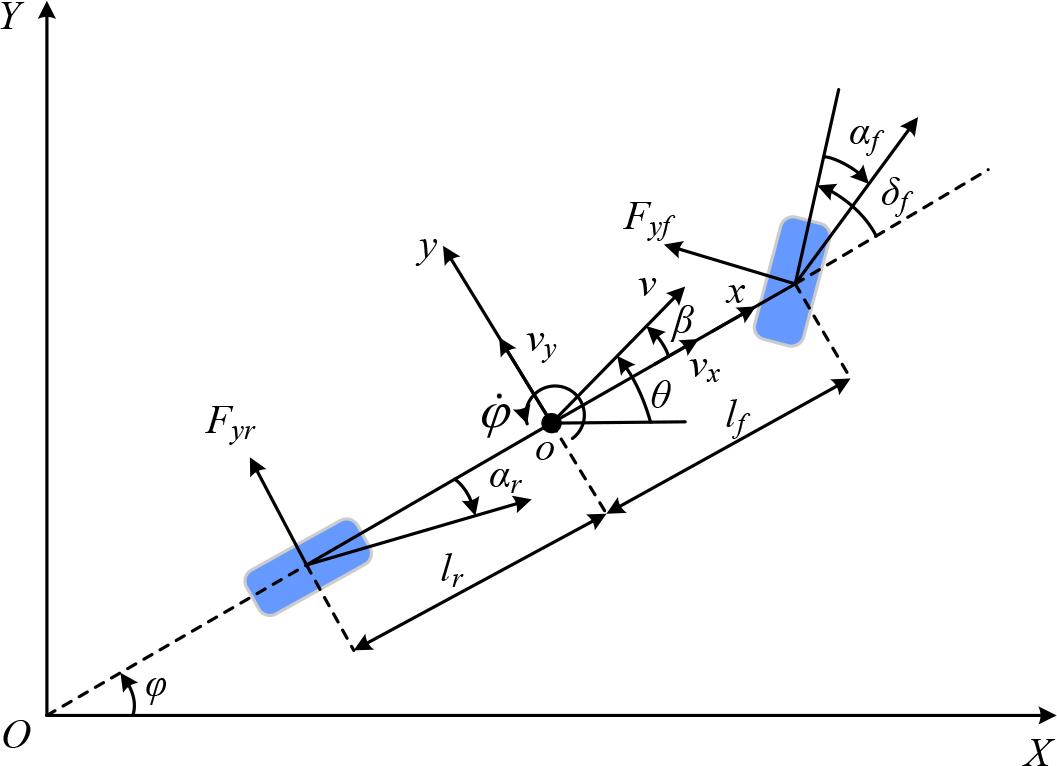
Two degrees of freedom vehicle dynamics model
In Fig. 1, coordinate system Σ
Where:
The tyre lateral force of a smart car can be expressed as a non-linear functional relationship as:
Where:
Neglecting the load transfer during travelling, the vertical loads
The slip rate of a tyre can be expressed as:
Where:
Combining Eq. (1) and Eq. (5) yields a nonlinear intelligent vehicle dynamics model with the following state space expression:
Where:
The smart car dynamics model built in this paper is biased to focus on lateral motion, so the magic tyre model with high fitting accuracy is chosen [27]. Its expression is:
Where:
Since tyres exhibit good linear properties at low slip rates and small lateral deflection angles, this paper thus exploits this property to further simplify the intelligent vehicle dynamics model in order to reduce the difficulty of controller design.
In the case of small tyre lateral deflection angle, the relationship between the lateral force of the tyre and the lateral deflection angle can be approximated as:
Where:
Assuming that the front wheel angle is small when the intelligent vehicle is performing path tracking, the following approximation can be made:
When the front wheel side deflection angle of the smart car is in a small range, the following approximation can be made:
Then the front and rear axial side deflections can be expressed as:
Combining equations (9) and (12), the front and rear wheel lateral forces can be expressed as:
In summary, the linear two-degree-of-freedom intelligent vehicle model is organised as:
Write Eq. (14) in the form of a state space equation as:
Based on the established linear two-degree-of-freedom intelligent car model, this paper establishes an intelligent car tracking error model. The smart car tracking error model is schematically shown in Fig. 2.
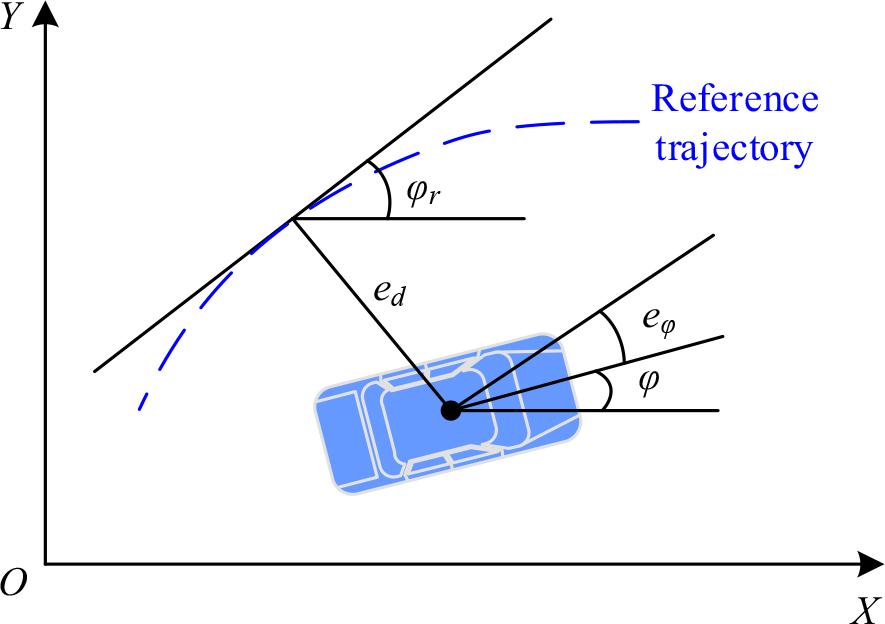
Schematic diagram of vehicle tracking error model
In Fig. 2,
From the road curvature of the reference trajectory, the reference heading angular velocity and the reference lateral acceleration can be derived as:
Where:
The second order derivative of the lateral error with respect to the heading angle error can be expressed as:
Combining Eq. (15) and Eq. (18) gives the smart car tracking error model:
Intelligent vehicle inverse longitudinal dynamics model mainly includes inverse engine model and inverse brake model, which are mainly used in the underlying output module of longitudinal controller.
The inverse engine model needs to be established in the drive mode, if the slope resistance and the rotating mass of the vehicle are ignored, the driving resistance is composed of rolling resistance
Where:
The acceleration generated by the travelling resistance
Where:
Rolling resistance
Where:
Air resistance
Where:
By analysing the vehicle power transmission system, the relationship equation between the driving force and engine output torque of the intelligent vehicle can be established:
Where:
Where:
According to the relationship between engine speed, throttle opening and torque, the engine output torque characteristic function can be established
Where:
In braking mode, the engine is in a hurry and the output torque is zero. At this time the resistance to the vehicle is braking force, air resistance, rolling resistance and grade resistance. Neglecting the grade resistance, the braking force
By analysing the relationship between braking force and braking torque, the braking torque can be expressed as:
If the braking torque of the brake disc is known, the brake master cylinder pressure is:
Where:
Optimal control theory begins with the extreme value principle, and its core idea can be summarised as follows: based on the optimal planning strategy, the overall planning problem is divided into several smaller sub-problems for planning [28].
To solve the optimal control problem, it is necessary to establish the process equations of the controlled system, specify the range of values of the control variables, and then give the initial and final states in the motion process and put forward a number of performance index functions for evaluating the advantages and disadvantages of the motion process according to the demand. Unlike other path planning algorithms that only output path or trajectory processes, when the optimal control theory is used to solve the motion planning problem, the programme can output the optimal trajectory and the corresponding optimal control process at the same time, and there will not be a situation in which the optimal trajectory exceeds the limitation range of the control variables, resulting in the situation of failure to execute.
In the automatic obstacle avoidance path planning for intelligent vehicles, the application of optimal control theory can help the vehicle to quickly calculate the obstacle avoidance path and speed curve when facing obstacles to ensure that the vehicle passes safely and efficiently, and significantly improve the safety and efficiency of the vehicle’s travelling.
In the process of automatic obstacle avoidance path planning for intelligent vehicles, in order to meet the needs of different scenarios, an evaluation function is constructed to evaluate and screen out the required trajectories. This paper combines and enhances the traditional evaluation function by constructing three performance index functions as the objective function to guide the direction of optimal control problem solving, requiring:
The intelligent vehicle reaches the target position and motion state at the final moment of path planning, and the intelligent vehicle is guaranteed to approach the target state quickly and smoothly during the motion process. The energy consumption of the output trajectory is minimised. From the point of view of practical use, avoiding non-essential rapid acceleration and deceleration, reducing energy consumption and saving fuel on the basis of ensuring driving comfort. Minimise the rate of change in the curvature of the output trajectory. Ensure driving safety and comfort, reduce the number and angle of steering wheel rotation, avoid the frequent operation of fine-tuning angle, and improve operation efficiency while reducing the number and amplitude of the steering mechanism angle change, with strong practicality while extending the life of the steering system. In order to measure the intelligent vehicle to achieve the predetermined target position and motion state at the moment of motion termination and to ensure driving efficiency during the motion process, the terminal performance index function is established:
The average power performance index function is established for the energy consumption during the movement of intelligent vehicles:
The average angular velocity rate of change performance index function was established for the ride comfort during the motion of intelligent vehicles:
In order to simultaneously meet the needs of intelligent vehicles to maintain high driving efficiency, reduce fuel consumption, and enhance the ride comfort of intelligent vehicles during the movement process, this paper establishes a comprehensive performance index function by adding weighting terms to the above three performance index functions:
Among them:
The above three performance indicators represent driving efficiency, energy consumption and ride comfort, respectively, which can basically meet the needs of intelligent vehicle driving in daily life, but over-pursuing driving efficiency will result in higher energy consumption due to faster speeds and intense driving behaviors in the driving process will also affect the ride comfort of the intelligent vehicle.
From the above example, it can be seen that there is a certain “hedge” between the three performance indicators. Under the premise of meeting the driving constraints of the intelligent vehicle, the weights of the three functions should be adjusted according to different scenarios and user preferences, so as to make the trajectory process and control process planned by the algorithm achieve the desired effect.
The optimization of the overall planning system and its output trajectory can be achieved by adjusting the weights of the three performance index functions according to the needs.
Traditional path planning algorithms are divided into two modules, local path planning and speed planning, and all of them adopt the algorithm of exhaustive selection in the planning process: firstly, all the possible driving trajectories are listed, and then the cost function is used to calculate the running cost of each trajectory, and then the most reasonable one is selected according to the demand. A large amount of computation makes the trajectory planning time too long, which is not in line with the characteristics of real driving that require quick reactions.
The traditional autonomous driving system’s planning of the driving trajectory can achieve the theoretical optimum in terms of robustness, but it does not match the physical characteristics of actual driving. For this kind of “invalid trajectory” that breaks through the performance limit of the intelligent car, the control module will approximate it to facilitate the execution, resulting in the real driving trajectory of the intelligent car not reaching the optimal, and the robustness performance under different road conditions is relatively poor.
Different from the traditional path planning algorithm, the algorithm based on the optimal control theory treats the intelligent vehicle as a controlled system and can simultaneously plan the optimal trajectory and the corresponding optimal control quantity to ensure that the output trajectory is reasonable and feasible. The optimal trajectory is searched out gradually according to the planning cycle, which avoids the introduction of unnecessary inferior trajectory quantities to participate in the operation, and also reduces the computation amount of the programme to a certain extent.
The mathematical description of the solution process of the optimal control problem in the automatic obstacle avoidance process of intelligent car lane changing is as follows:
The start time of intelligent vehicle path planning is
The inputs of the intelligent car’s motion state at the initial moment are specified as
The optimisation objective is formulated as:
The optimal control model will plan the optimal state quantities and optimal control quantities in the motion process according to the given start and end states of the intelligent vehicle, conforming to the constraints and the objective function, which are mathematically described as follows:
In Eq. (37),
The smart car kinematic state vector is:
The reference input vector is:
The computational flow of automatic obstacle avoidance path planning for intelligent vehicles based on optimal control theory is shown in Fig. 3.
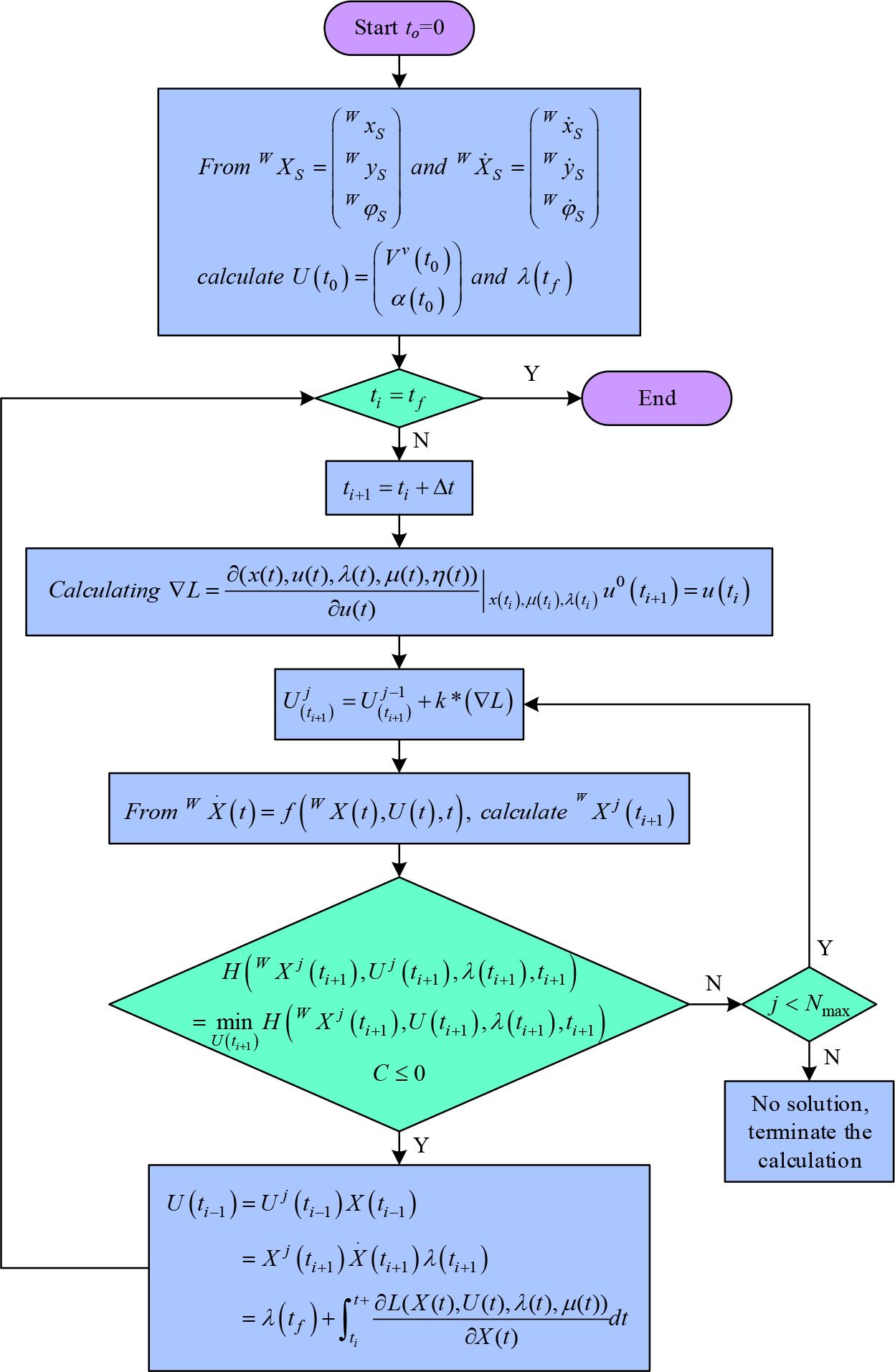
The calculation flowchart of intelligent car path planning
The automatic obstacle avoidance path planning method for intelligent vehicles based on optimal control theory proposed in this paper organically integrates local path planning, trajectory planning, and kinematic inverse solutions in traditional path planning into an optimal control model. Its advantage lies in the fact that the constraints of the model comprehensively consider obstacle avoidance requirements, traveling space constraints, kinematic model constraints, and motion performance constraints of the intelligent vehicle. The objective general function of the model is a hybrid objective general function, which comprehensively considers the movement time, initial state, target state, driving efficiency, energy consumption, and ride comfort of the intelligent vehicle movement.
In order to verify the effectiveness of the intelligent vehicle automatic obstacle avoidance path planning algorithm based on the optimal control theory proposed in this paper, simulation experiments will be designed in this chapter in terms of road curvature situation and obstacle movement situation, respectively.
This section deals with obstacle avoidance path planning by separating it into straight bypass scenarios and curved bypass scenarios, and the simulation calculation and visualisation analysis are carried out in Matlab.
The simulation results of automatic obstacle avoidance for intelligent vehicles under straight road conditions are shown in Fig. 4. Among them, Figs. (a)~(d) represents the vehicle planning path when there is no obstacle, the candidate path when obstacles are added, the vehicle planning path under three obstacles, and the vehicle planning path under four obstacles, respectively. The grey rectangular box is the obstacle vehicle, the purple trajectory is the optimal candidate path point screened using the traditional evaluation function, and the orange trajectory is the smooth trajectory that satisfies the controlled intelligent vehicle’s safety in obstacle avoidance, ride comfort, and minimum fuel consumption, which is obtained using the path planning performance index function based on the optimal control theory in this paper.
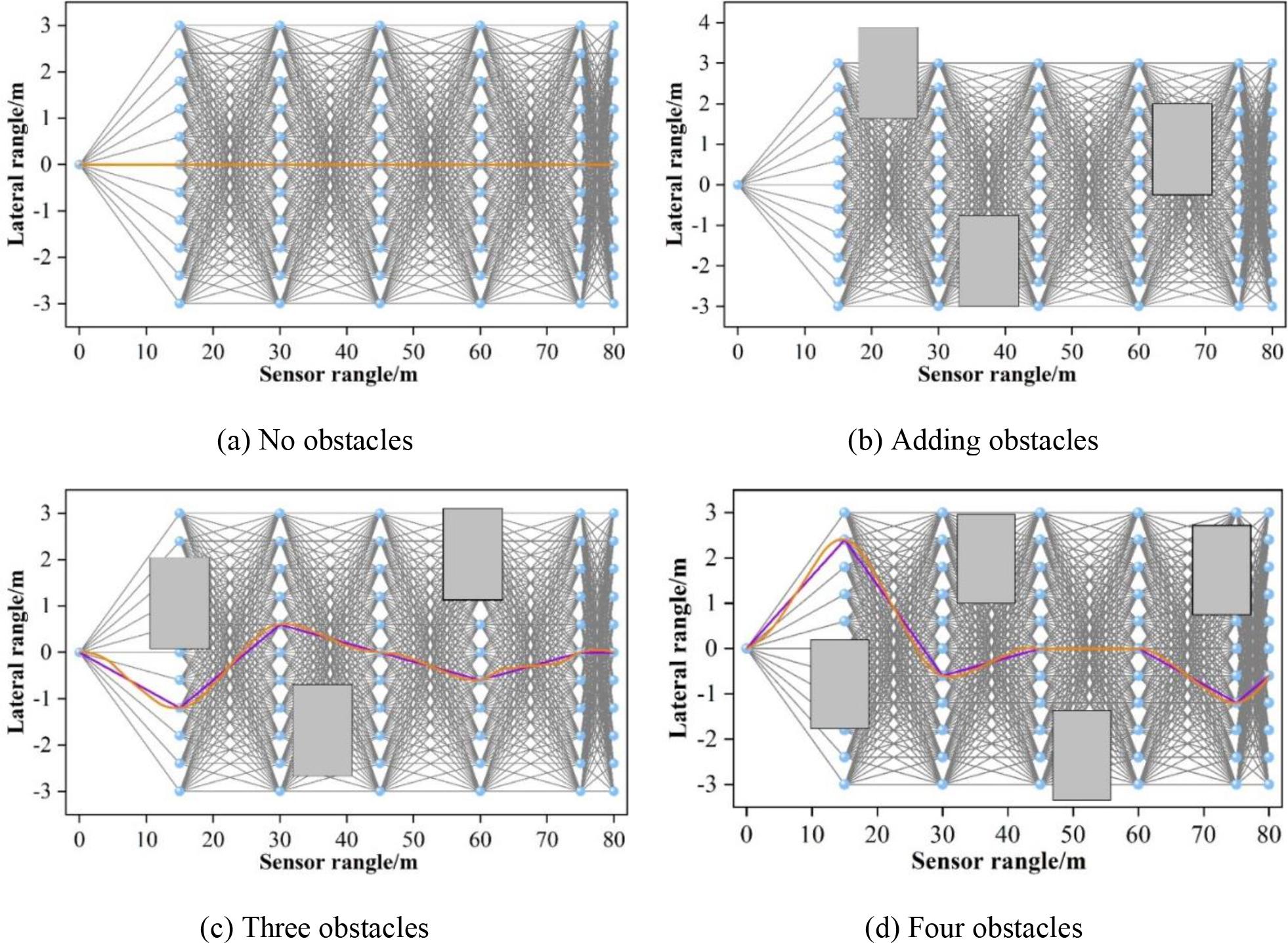
Simulation results of obstacle avoidance under straight road conditions
As can be seen from Fig. 4, the controlled vehicle keeps a straight line at the point (0, 0), and the transverse and longitudinal scattering points are carried out for a section of the future driving area of the controlled vehicle. The transverse scattering points in this experiment are 11, with a transverse interval of 0.6m. The longitudinal scattering points are 6, with a longitudinal interval of 15m in addition to the endpoints, in order to ensure that the transverse and longitudinal velocities and accelerations of the neighbouring connected points are the same. Fig. 4(c) and Fig. 4(d) set up an arbitrary position of the obstacle, and its experimental results show that the planning path of this paper’s path planning method and the planning path of the traditional path planning method is relatively consistent in general, i.e., this paper’s method achieves the application effect of the traditional path planning algorithms under the premise of comprehensively considering the travelling efficiency, energy consumption, and ride comfort, which shows that this paper’s path planning method based on the theory of optimal control has a good effect in the obstacle avoidance effectiveness under straight road conditions.
In this paper, the curved road scenario is analyzed in the intelligent vehicle automatic obstacle avoidance simulation experiment, and the optimal trajectory screening results under arbitrary curved road conditions are shown in Fig. 5. Among them, Figs. (a)~(c) indicates that the experiments are randomly set up with three different randomly varying curvature trajectories, a, b and c, and the position of obstacles is set up arbitrarily; the purple line is the rough optimal candidate path calculated by the traditional evaluation function, and the orange line is the optimal candidate trajectory obtained by using the path planning performance index function based on the optimal control theory to satisfy the ride comfort of the controlled vehicle.
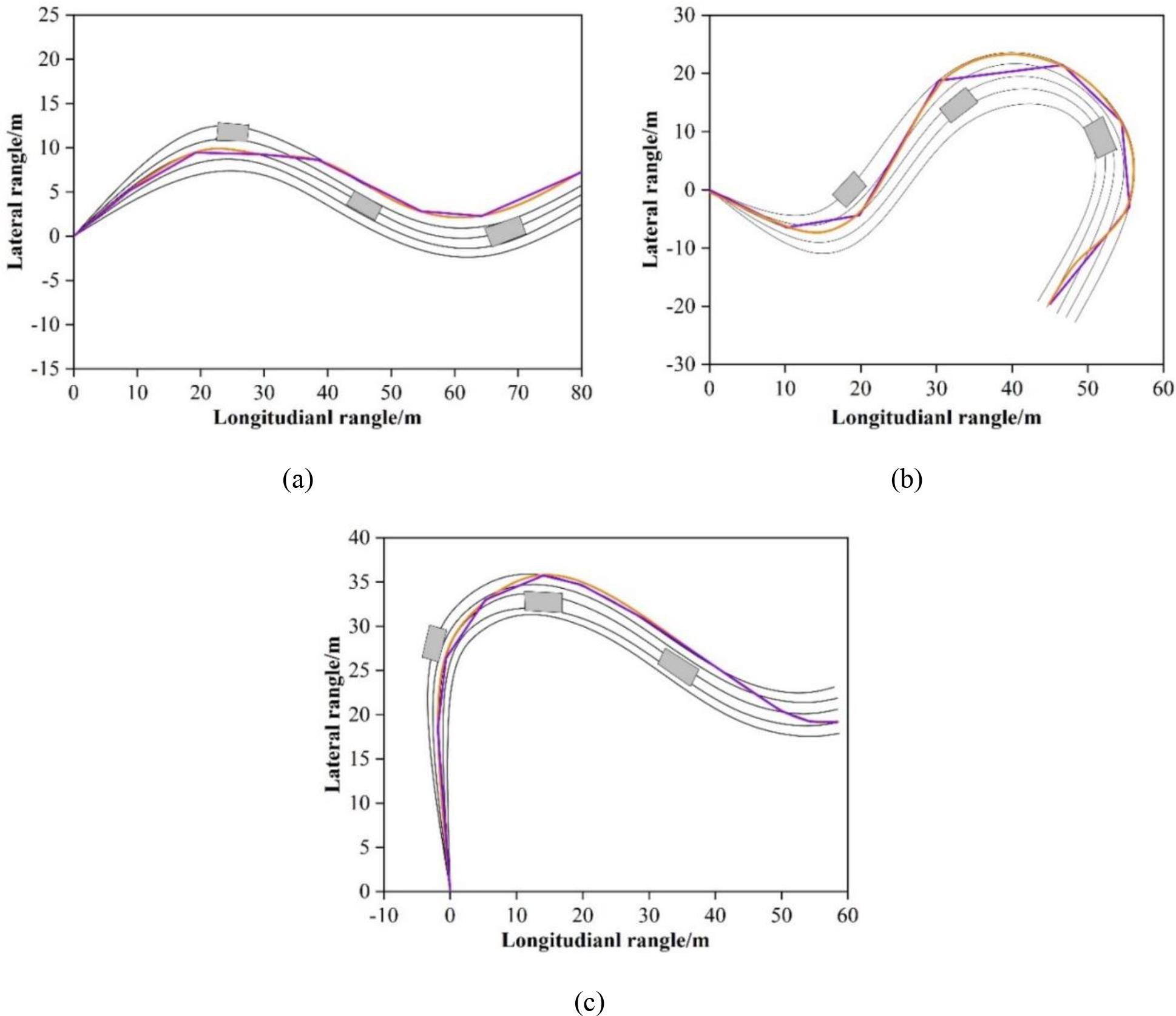
The optimal trajectory screening results of any curve road condition
As can be seen from Figure 5, the path planning performance index function and the optimal path planning method proposed in this paper can meet the obstacle avoidance requirements of local path planning and ensure ride comfort, which verifies the effectiveness of the optimal control theory in the optimisation of automatic obstacle avoidance path planning for intelligent vehicles.
In order to verify the feasibility of the proposed obstacle avoidance path planning algorithm, in this section, a joint simulation using Carsim and Matlab/Simulik is carried out to test the obstacle avoidance effect of the path planning algorithm from two perspectives: static obstacles and dynamic obstacles.
The static vehicle obstacle specific simulation cases are implemented as follows respectively:
Straight line test case Y=1, obstacle positions are located on the global coordinate system (171,0.85), (171,1.34), (174.5,0.85), (174.5,1.34), (178,0.85), (178,1.34), ground attachment coefficient is 0.8, the vehicle speeds are 63km/h, and 84km/h, and the weights of the obstacle avoidance function are 100.
A comparison of the driving curve results of the smart car with a speed of 63km/h under straight-line conditions is shown in Fig. 6. Where (a)~(b) represent the longitudinal displacement-transverse displacement curve and the longitudinal displacement-transverse swing angle curve, respectively.
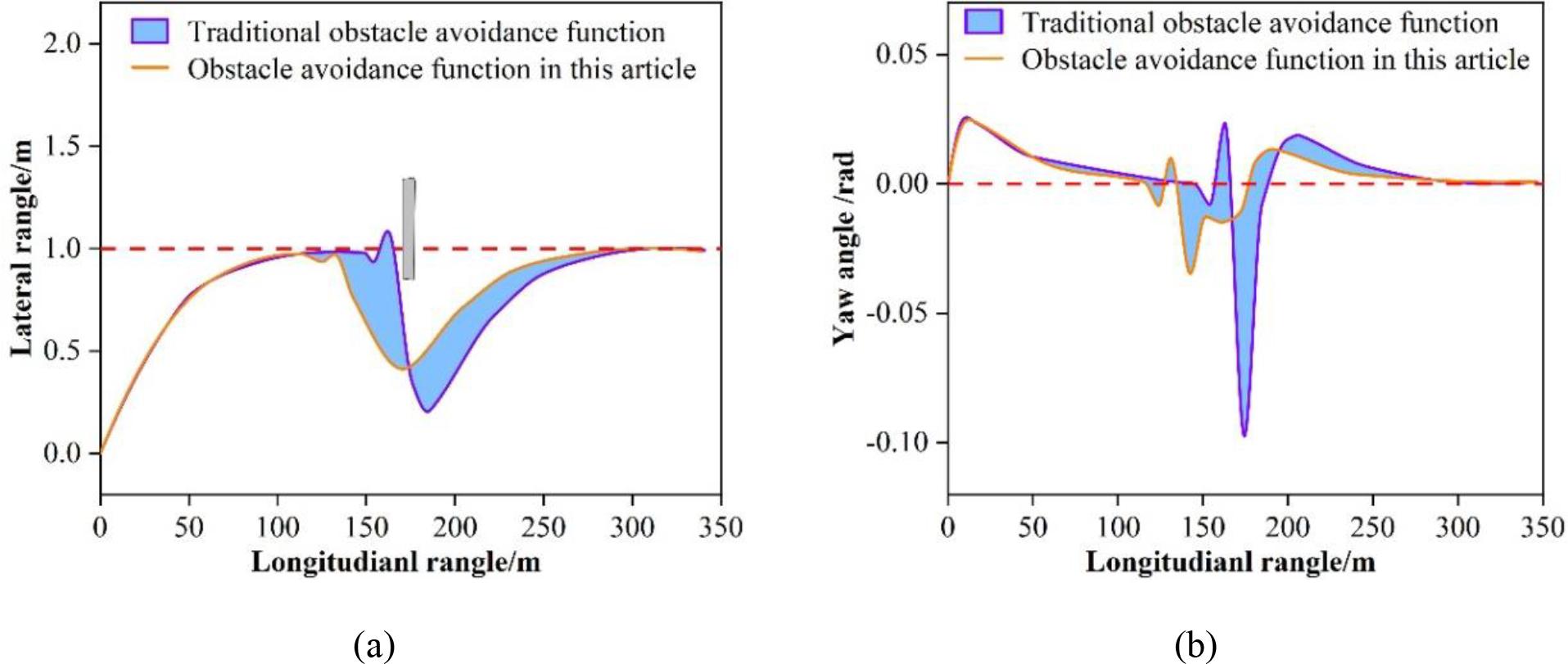
Comparison of static obstacle avoidance results under linear conditionat 63 km/h
From Fig. 6(a), it can be seen that when the vehicle speed is 63km/h. There is a static obstacle on the straight line condition. Using the proposed obstacle avoidance path planning function in this paper at 133m, the trajectory tends to bypass the obstacle. The maximal distance away from the obstacle is 0.43m, whereas the traditional obstacle avoidance function tends to bypass the obstacle at 162m, and the maximal distance away from the obstacle is 0.64 m. From Fig. 6(b), it is shown in Fig. 6(c). m. As can be seen in Fig. 6(b), when there is a static obstacle on the straight line condition, and the vehicle speed is 63km/h, the absolute value of the vehicle’s traverse angle using the obstacle avoidance path planning function in this paper is 0.035rad, which is lower than that of the traditional obstacle avoidance function’s absolute value of the maximum traverse angle of 0.097rad.
A comparison of the driving curve results of the smart car with a speed of 84km/h under straight-line operating conditions is shown in Fig. 7. (a) and (b) represent the longitudinal displacement-transverse displacement curve and the longitudinal displacement-transverse swing angle curve, respectively.
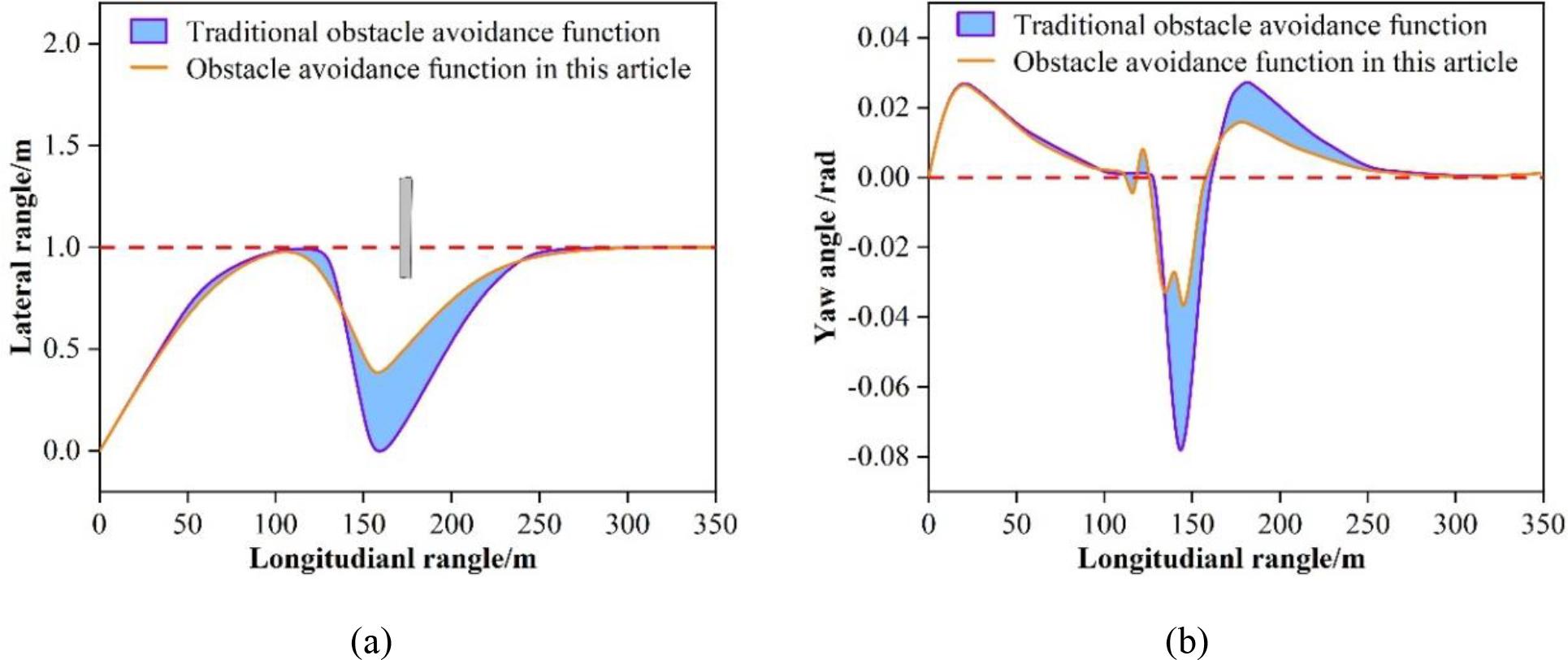
Comparison of static obstacle avoidance results under linear condition at 84 km/h
As can be seen from Fig. 7, when the vehicle speed is 84km/h in straight line conditions, the planning path of the obstacle avoidance function proposed in this paper has begun to bypass the static obstacles at 104m, and the maximum distance away from the obstacles is 0.46m, while the traditional obstacle avoidance function begins to bypass the static obstacles at 125m, and the maximum distance away from the obstacles is 0.86m. At this time, the maximum transverse pendulum angle of the vehicle adopting the planning function of the obstacle avoidance path in this paper is 0.037 absolute value, and the absolute value is 0.037 absolute value. The absolute value is 0.037rad, while the traditional obstacle avoidance function reaches 0.079rad.
In summary, when there is a static obstacle on the reference trajectory, both obstacle avoidance functions can make the intelligent car bypass the obstacle, but the obstacle avoidance function based on the optimal control theory proposed in this paper has better performance, which not only can generate the tendency of bypassing the obstacle in time, but also the tendency of bypassing is smoother, which avoids the safety hazards and at the same time, it can also bring a better sense of comfort to the passengers.
The dynamic obstacle avoidance simulation case is implemented as follows:
Intelligent car from the origin tracking straight line test condition Y = 1, the initial position of the obstacle is located in the global coordinate system (150,1.7), (150,2.2), (154,1.7), (154,2.2), (158,1.7), (158,2.2), and the obstacle is at the speed of 0.13m/s speed from the starting point downward, the ground attachment coefficient of 0.8, the vehicle speed is 63km/h, the weights of the obstacle avoidance function are 100, the results of this paper and the traditional obstacle avoidance function simulation results are Figure 8, respectively. 0.8, the vehicle speed is 63km/h, respectively, and the weights of the obstacle avoidance function are 100, so the simulation results of this paper’s obstacle avoidance function and the traditional obstacle avoidance function are shown in Fig. 8 and Fig. 9, respectively. In Fig. 8 and Fig. 9, the blue dashed line and the shaded part are the local paths planned in real time, the orange solid line indicates the position of the vehicle when planning the corresponding local paths, the long white bar represents the obstacle, and the black block represents the obstacle driving trajectory.

The simulation results of the obstacle avoidance function in this article

Simulation results of the traditional obstacle avoidance function
Comparing Fig. 8(a) and Fig. 9(a), it can be seen that in tracking straight-line conditions facing dynamic obstacles, the obstacle avoidance function used in this paper starts to avoid and replan the corresponding paths when the simulation time is 8s, while the traditional obstacle avoidance function has not yet made the corresponding response at this time.
A comparison of Figure 8 (b) and Figure 9 (b) can be seen in the role of the two kinds of obstacle avoidance functions. The vehicle in 12s has been in the obstacle above to avoid the possibility of collision between the vehicle and the obstacle, but this paper adopts the obstacle avoidance function of the maximum avoidance distance of 0.4m, while the traditional obstacle avoidance function of the avoidance distance of 0.9m or so, which seriously affects the comfort of the passenger ride.
Comparing Fig. 8(c) and Fig. 9(c), it can be seen that when the vehicle completely bypasses the obstacle, the obstacle avoidance function proposed in this paper begins to travel in accordance with the corresponding desired trajectory in about 16s, while the travelling path of the traditional obstacle avoidance function still has a large deviation. Considering the distance between the vehicle speed and the obstacle speed direction perpendicular to each other as a performance index, the value of this index is 0.85 and 0.45 under the traditional obstacle avoidance function and the obstacle avoidance function based on the optimal control theory in this paper. Therefore, the proposed obstacle avoidance function in this paper improves the performance of the traditional obstacle avoidance function by 47% compared to the traditional obstacle avoidance function.
Taken together, this shows that the proposed obstacle avoidance function based on optimal control theory is not only able to avoid collision with obstacles when facing dynamic obstacles but also able to plan smoother local paths in order to shorten the passenger’s ride time. Therefore, the path planned using the proposed obstacle avoidance function in the obstacle avoidance planner has a more reliable performance.
In this paper, by constructing the dynamics model of the intelligent vehicle and constructing the path planning performance index function, the design of the automatic obstacle avoidance path planning algorithm of the intelligent vehicle based on the optimal control theory is implemented, and the algorithm is simulated and analysed.
In the simulation experiments under different road curvature conditions, the planning paths of this paper’s path planning method and the traditional path planning method are relatively consistent in general, i.e., this paper’s method achieves the application effect of the traditional path planning algorithm under the premise of comprehensively considering the travelling efficiency, energy consumption and ride comfort, which indicates that the path planning performance index function and the optimal path planning method proposed in this paper can meet the requirements of obstacle avoidance in local path planning and guarantee the optimal control theory and the optimal control theory. It shows that the optimal path planning performance index function and optimal path planning method proposed in this paper can meet the requirements of local path planning for obstacle avoidance and ensure the comfort of the ride, which verifies the effectiveness of the optimal control theory in the optimisation of automatic obstacle avoidance path planning for intelligent vehicles.
When the vehicle speed is 63km/h and 84km/h under straight line working conditions, the proposed obstacle avoidance path planning function starts to bypass the obstacle at 133m and 104m, respectively, which is earlier than the traditional obstacle avoidance function at 162m and 125m, and the maximum distance away from the obstacle and the corresponding swing angle of the vehicle are smaller than the traditional function. Considering the distance between the vehicle speed and the obstacle speed direction perpendicular to the two as a performance index, the traditional obstacle avoidance function and this paper based on the optimal control theory of the obstacle avoidance function of the index value of 0.85 and 0.45, respectively, this paper’s obstacle avoidance function compared to the traditional obstacle avoidance function of the performance of the improvement of 47%. It shows that the optimal control theory based obstacle avoidance function proposed in this paper has better performance than the traditional obstacle avoidance function, which can not only produce the trend of bypassing obstacles in time but also the trend of bypassing is smoother, avoiding the safety hazards and at the same time, it can also bring a better sense of comfort to the passengers.
